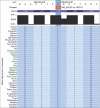Clinical Next Generation Sequencing Reveals an H3F3A Gene as a New Potential Gene Candidate for Microcephaly Associated with Severe Developmental Delay, Intellectual Disability and Growth Retardation
- PMID: 31942419
- PMCID: PMC6956640
- DOI: 10.2478/bjmg-2019-0028
Clinical Next Generation Sequencing Reveals an H3F3A Gene as a New Potential Gene Candidate for Microcephaly Associated with Severe Developmental Delay, Intellectual Disability and Growth Retardation
Abstract
Microcephaly is characterized by significant clinical and genetic heterogeneity, therefore reaching the genetic diagnosis remains challenging in this group of disorders. We describe a case of a girl with secondary microcephaly, associated with severe developmental delay, intellectual disability, growth retardation and dysmorphic features. For purposes of clinical genetic diagnostic testing, we performed trio whole exome sequencing in the proband and unaffected parents. We found a heterozygous de novo missense variant in the H3F3A gene in the proband (NM_ 002107.4: c.185T>G), which is absent from the gnomAD and from the Slovenian Genome databases. The identified variant affects a highly conserved leucine residue at position 62 of the histone H3 protein (H3.3) and is predicted to affect the physicochemical properties of the affected protein. Mouse models, which demonstrated involvement of H3.3 protein in the control of neuronal- and glial-specific gene expression patterns that control synaptic connectivity and behavioral plasticity. Additionally, we also identified similar cases reported in the ClinVar database. These arguments support the possible pathogenic role of the reported genetic variant and thus suggest a novel molecular mechanism for this syndromic form of microcephaly.
Keywords: Growth delay; H3F3A gene; Microcephaly; Severe developmental delay; intellectual disability.
© 2019 Maver A, Čuturilo G, Ruml Stojanović J, Peterlin B, published by Sciendo.
Figures


Similar articles
-
Novel de novo SPOCK1 mutation in a proband with developmental delay, microcephaly and agenesis of corpus callosum.Eur J Med Genet. 2014 Mar;57(4):181-4. doi: 10.1016/j.ejmg.2014.02.009. Epub 2014 Feb 27. Eur J Med Genet. 2014. PMID: 24583203
-
Evaluating the Role of MAST1 as an Intellectual Disability Disease Gene: Identification of a Novel De Novo Variant in a Patient with Developmental Disabilities.J Mol Neurosci. 2020 Mar;70(3):320-327. doi: 10.1007/s12031-019-01415-8. J Mol Neurosci. 2020. PMID: 31721002
-
Two novel EIF2S3 mutations associated with syndromic intellectual disability with severe microcephaly, growth retardation, and epilepsy.Am J Med Genet A. 2016 Nov;170(11):2927-2933. doi: 10.1002/ajmg.a.37792. Epub 2016 Jun 22. Am J Med Genet A. 2016. PMID: 27333055
-
A de novo mutation in RPL10 causes a rare X-linked ribosomopathy characterized by syndromic intellectual disability and epilepsy: A new case and review of the literature.Eur J Med Genet. 2018 Feb;61(2):89-93. doi: 10.1016/j.ejmg.2017.10.011. Epub 2017 Oct 21. Eur J Med Genet. 2018. PMID: 29066376 Review.
-
Case report of novel DYRK1A mutations in 2 individuals with syndromic intellectual disability and a review of the literature.BMC Med Genet. 2016 Feb 27;17:15. doi: 10.1186/s12881-016-0276-4. BMC Med Genet. 2016. PMID: 26922654 Free PMC article. Review.
Cited by
-
Analysis of histone variant constraint and tissue expression suggests five potential novel human disease genes: H2AFY2, H2AFZ, H2AFY, H2AFV, H1F0.Hum Genet. 2022 Aug;141(8):1409-1421. doi: 10.1007/s00439-022-02432-1. Epub 2022 Jan 24. Hum Genet. 2022. PMID: 35072799
-
Assessing contributions of DNA sequences at the 3' end of a yeast gene on yFACT, RNA polymerase II, and nucleosome occupancy.BMC Res Notes. 2024 Aug 6;17(1):219. doi: 10.1186/s13104-024-06872-y. BMC Res Notes. 2024. PMID: 39103906 Free PMC article.
-
Histone 3.3-related chromatinopathy: missense variants throughout H3-3A and H3-3B cause a range of functional consequences across species.Hum Genet. 2024 Apr;143(4):497-510. doi: 10.1007/s00439-023-02536-2. Epub 2023 Mar 3. Hum Genet. 2024. PMID: 36867246 Review.
-
De novo variants in H3-3A and H3-3B are associated with neurodevelopmental delay, dysmorphic features, and structural brain abnormalities.NPJ Genom Med. 2021 Dec 7;6(1):104. doi: 10.1038/s41525-021-00268-8. NPJ Genom Med. 2021. PMID: 34876591 Free PMC article.
-
Dominant effects of the histone mutant H3-L61R on Spt16-gene interactions in budding yeast.Epigenetics. 2022 Dec;17(13):2347-2355. doi: 10.1080/15592294.2022.2121073. Epub 2022 Sep 8. Epigenetics. 2022. PMID: 36073733 Free PMC article.
References
-
- Woods GC, Parker A. Investigating microcephaly. Arch Dis Child. 2013;98(9):707–713. - PubMed
-
- Hagen M, Pivarcsi M, Liebe J, Bernuth H, Didonato N, Hennermann JB. Diagnostic approach to micro cephaly in childhood: A two center study and review of the literature. Dev Med. Child Neurol. 2014;56(8):732–41. et al. - PubMed
-
- Maver A, Čuturilo G, Kovanda A, Miletić A, Peterlin B. Rare missense TUBGCP5 gene variant in a patient with primary microcephaly. Eur J Med Genet. 2019;65(12):103598. - PubMed
LinkOut - more resources
Full Text Sources
